FIGURE 1. Locations of the Puryear (UF15820) and Warman (UF15826) clay pits in western Tennessee (TN) and the Bovay (UF15737) and Bolden (UF15738) clay pits in northern Mississippi (MS), southeastern USA. Scale bar is for Benton and Marshall counties of Mississippi and Henry and Weakley counties of Tennessee.

FIGURE 2. Simplified stratigraphic column of the middle Eocene Claiborne Group in northern Mississippi and western Tennessee (after Dockery, 1996). Specimens examined in this paper were collected from the Cockfield Formation at the Puryear locality (P), Tennessee. Specimens from other localities used for comparison were collected from the Tallahatta Formation at the Bovay and Bolden localities (BB), Mississippi and the Cockfield Formation at the Warman clay pit (W; stratigraphically lower than the Puryear locality), Tennessee.

FIGURE 3. Claiborne Arecaceae Infructescence Type 1: 1) UF15820-059399, showing an infructescence with at least two terminal sessile fruits and a lateral projection; 2) UF15820-059399, counterpart showing at least three fruits. All scale bars equal 3 mm.

FIGURE 4. Claiborne Arecaceae Fruit Type 1: UF15820-059477, laterally compressed fruit with fibers. Note that curved fibers (indicated by arrows) extend from the base to beyond the apex of the fruit. Scale bar equals 2 mm.

FIGURE 5. Ceratophyllum muricatum Chamisso subspecies incertum (Berry) Herendeen, Les and Dilcher, 1990: 1) CONN-Q12-03, specimen showing fruit body and lateral spines; 2) CONN-Q12-04, an incomplete fruit showing lateral spines. All scale bars equal 2 mm.

FIGURE 6. Protomimosoidea buchananensis Crepet and Taylor, 1986: UF15820-061118, flower showing multiple filaments with anthers missing. Scale bar equals 1 mm.

FIGURE 7. Claiborne Fabaceae Floral Type 1: UF15820-061142, a laterally compressed flower with three perianth parts and pedicel. Scale bar equals 2 mm.

FIGURE 8. Claiborne Fabaceae Floral Type 2: UF15820-043606, flower with numerous stamens (indicated by arrow). Scale bar equals 1 mm.

FIGURE 9. Claiborne Fabaceae Floral Type 3: UF15820-043630, flower showing at least two valvate petals (pt), anther (a), style (st), and ovary (o). Scale bar equals 1 mm.

FIGURE 10. Caesalpinia claibornensis Herendeen and Dilcher, 1991: 1) UF15820-005854, incomplete fruit showing both valve and wing venation; 2) UF15820-005855, incomplete fruit showing both valve and wing venation. All scale bars equal 5 mm.

FIGURE 11. cf. Caesalpinia sp.: 1) UF15820-005862, fruit showing at least seven seed chambers, one seed impression in valve (indicated by arrow), and angular apex on the right. Scale bar equals 4 mm; 2) UF15820-008961, fruit showing seven seed chambers, oblique striations (os), and obtuse apex on the right. Scale bar equals 4 mm.

FIGURE 12. cf. Cladrastis sp.: 1) UF15820-005419, fruit with two parallel seeds (s), narrow wing (w) along placental suture, and stipe (st); 2) Counterpart of UF15820-005419; 3) UF15820-009012, fruit showing narrow wing (w) along placental suture, obtuse apex, and style (stl) on the right. All scale bars equal 2 mm.

FIGURE 13. “Fruits similar to the Sophoreae” 1) UF15820-005847, fruit showing obtuse apex on the right and rounded base with stipe (s) on the left, and funiculus (f); 2) UF15820-000025a, fruit showing outlines of ovules (indicated by arrows), and rounded base with stipe on the right. All scale bars equal 2 mm.

FIGURE 14. “Short, broad winged fruit” 1) UF15820-007696, fruit showing acuminate apex (a), wing (w) along placental suture, and valve venation (v); 2) UF15820-007679, fruit showing stipe (s), wing (w) along placental suture, and valve venation (v); 3) UF15820-005834, fruit showing stipe (s) and wing (w) along placental suture; 4) UF15820-007082, fruit showing wing (w) along placental suture and valve venation (v). All scale bars equal 5 mm.

FIGURE 15. cf. Leguminosites ingafructoides Berry, 1930: UF15820-005843, fruit showing wide sutures (s), constriction (c) and vertical partition, and oblique striations (os) that are oriented parallel to the direction of the arrows. Scale bar equals 5 mm.

FIGURE 16. Claiborne Fabaceae Fruit Type 1: 1) UF15820-061134, showing nutlet in the middle, large wing at the top and small wing at the bottom. Arrows a and b indicate areas to be enlarged to show spines on the nutlet. The other two arrows on the right indicate that the two wings are on different levels with clay infilling between them. Scale bar equals 3 mm; 2) Enlargement of a in Figure 16.1 to show spines. Scale bar equals 1 mm; 3) Enlargement of b in Figure 16.1 to show spines going underneath the small wing. Scale bar equals 1 mm; 4) UF15820-059396, showing a pedicel (p) - or gynophore and spines (s). Scale bar equals 3 mm.

FIGURE 17. Claiborne Fabaceae Fruit Type 1: CONN-R03-01, compressed fruit showing a long pedicel and spines (indicated by arrow). Scale bar equals 3 mm.

FIGURE 18. Pteroceltis knowltonii (Berry) Manchester, Chen, Lu and Uemura, 2009: 1-2) UF15820-029089, 029089', part and counterpart of specimen showing the short stipe (s). Scale bar equals 5 mm; 3) UF15820-055903, specimen showing cordate base, stipe (s) at the base, two styles at the distal end (indicated by arrows), and asymmetric fruit body and wings of different sizes. Scale bar equals 3 mm; 4-5) UF15820-055902, 055902', part and counterpart of specimen showing stipe (s) at the base and two styles at the distal end (indicated by the arrows). Scale bar equals 4 mm; 6) UF15820-059397, specimen showing stipe (s). Scale bar equals 4 mm.

FIGURE 19. Eoceltis dilcheri Zavada and Crepet, 1981: 1) 15816-001356, specimen showing two flowers each with three tepals. Note filaments (f) and dense, simple trichomes (t). Scale bar equals 1 mm; 2) UF15816-000455, showing a flower with four tepals covered with dense, simple trichomes (t). Scale bar equals 1 mm.

FIGURE 20. Castanopsoidea columbiana Crepet and Nixon, 1989: 1) UF15820-061131, showing an incomplete, unbranched infructescence. Scale bar equals 5 mm; 2) Enlargement of Figure 20.1 to show transversely arranged scales on the cupule (indicated by arrows). Scale bar equals 1 mm; 3) UF15820-061131', counterpart specimen showing scales with acute apices. Scale bar equals 5 mm; 4) UF15820-059483, showing a sessile fruit with spiny scales. Scale bar equals 2 mm; 5) UF15820-059490a, proximal portion of an incomplete infructescence showing four cupules. Note one cupule is detached. Scale bar equals 5 mm.

FIGURE 21. cf. Trigonobalanoidea americana Crepet and Nixon, 1989: 1) UF15820-061130, showing an infructescence with seven attached fruits. Note that one fruit is missing but the pedicel (indicated by arrow) is attached to the axis. Scale bar equals 3 mm; 2) Enlargement of Figure 21.1 to show two fruits. Note a central groove (indicated by two white arrows) and a short pedicel (indicated by bottom arrow), and persistent perianth parts (p). Scale bar equals 1 mm.

FIGURE 22. Claiborne Fagaceae Fruit Type 2: 1) UF15820-004016, base of cupule showing concentric arrangement of spines (indicated by arrow). Note at least six concentric circles; 2) UF15820-004016', note simple spines (indicated by arrow); 3) UF15820-004020, base of cupule showing attachment scar (indicated by arrow) and apically curved spines; 4) UF15820-061121, showing curved spines (indicated by arrow); 5) UF15820-032202, a large fruit about 5 cm in diameter. Note curved, simple spines (indicated by arrow). All scale bars equal 5 mm.

FIGURE 23. Claiborne Fagaceae Fruit Type 5: 1) UF15820-004015, fruit showing branched spines (indicated by arrows); 2) UF15820-004025, fruit showing two superimposed valves with clay filled in between them (indicated by lower left arrows) and branching and intertwining spines (indicated by top arrow); 3) UF15820-032853, fruit showing valves with distal portions of spines missing and only proximal web-like valve preserved (indicated by arrow). All scale bars equal 3 mm.

FIGURE 24. Claiborne Fagaceae Fruit Type 6: 1) UF15820-004019, fruit showing three cupules (cupule valves - indicated by black arrows) and axis (pedicel - indicated by white arrow); 2) UF15820-059411, fruit showing three cupules (cupule valves - indicated by arrows) and simple spines. All scale bars equal 3 mm.

FIGURE 25. Palaeocarya puryearensis (Berry) Manchester, 1987: 1) 15820-00410 (CONN), showing trilobate fruit wing and bilobed prophyllum (indicated by arrows). Scale bar equals 3 mm; 2) Enlargement of Figure 25.1 to show bilobed prophyllum (indicated by arrows). Scale bar equals 1 mm; 3) UF15820-001950, showing the central bract and poorly preserved lateral bracts. Scale bar equals 3 mm; 4) Enlargement of the left portion of the central bract to show venation and trichomes (indicated by arrow). Scale bar equals 1 mm; 5) UF15820-002214, showing the central bract and one lateral bract. Arrow indicates the prophyllum. Scale bar equals 3 mm.

FIGURE 26. Paraengelhardtia eocenica Berry, 1916: 1) UF15820-004854, specimen showing a small nutlet (n) impression and the prophyllum (p) extending almost four-fifths of the fruit wing (w). Scale bar equals 3 mm; 2) CONN-Q3-02, compressed specimen showing nutlet and fruit wing. Scale bar equals 3 mm.

FIGURE 27. Crepetocarpon perkinsii (Berry) Dilcher and Manchester, 1988, UF15820-059480, compressed fruit with radiating ridges. Scale bar equals 2 mm.

FIGURE 28. Claiborne Altingiaceae Infructescence Type 1: 1) UF15820-43600, infructescence with cluster of fruits. Scale bar equals 3 mm; 2) UF15820-059407, infructescence with cluster of fruits and peduncle. Scale bar equals 2 mm.

FIGURE 29. Liquidambar ? sp.: CONN-Q12-01, laterally compressed infructescence with persistent styles. Scale bar equals 4 mm.

FIGURE 30. Andrewsiocarpon puryearensis sp. nov. 1) UF15820-61133, specimen showing five seeds (s) and four valves (v). Note the central columella is inferred by the circular depression (indicated by the white arrow) and the fifth valve is inferred by the depression at the bottom of the capsule (indicated by the black arrow). Scale bar equals 5 mm; 2) UF15820-059410, showing two laterally compressed valves, pedicel (p), and a central columella (c). Scale bar equals 5 mm.
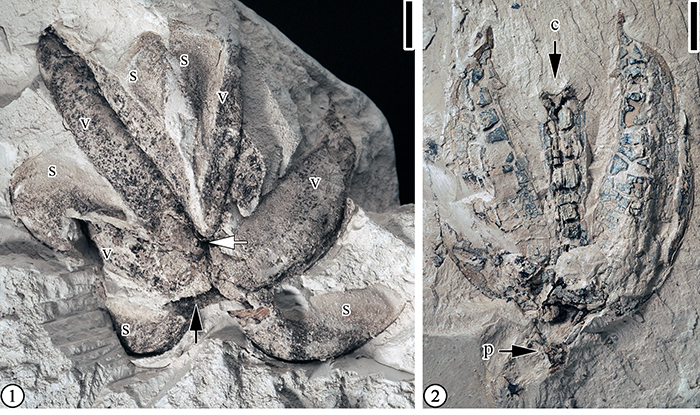
FIGURE 31. Paleopanax puryearensis sp. nov.: 1, 2) UF15820-053151, 053151', part and counterpart of the holotype specimen showing laterally compressed, orbicular fruit with two persistent styles, two D-shaped carpels, and a pedicel. Scale bars equal 3 mm; 3, 4) Enlargements of Figure 31.1, 2, respectively, to show the curved styles and an epigynous disc (indicated by arrows). Scale bars equal 1 mm; 5, 6) UF15820-59481, 59481', part and counterpart of the paratype specimen showing D-shaped carpels. Scale bars equal 3 mm.

FIGURE 32. Fraxinus wilcoxiana (Berry) Call and Dilcher, 1992: 1) UF15820-011008, specimen showing an emarginate wing apex; 2) UF15820-011010, specimen showing a well-demarcated seed and acute wing apex; 3) UF15820-011016, specimen showing a well-demarcated seed and rounded apex; 4) UF15820-011014, specimen showing a narrow elliptic samara; 5) CONN-Q11-P1a, specimen showing a relatively large seed and a short, stout pedicel; 6) UF15820-011001, specimen showing a relatively long pedicel. All scale bars equal 3 mm.
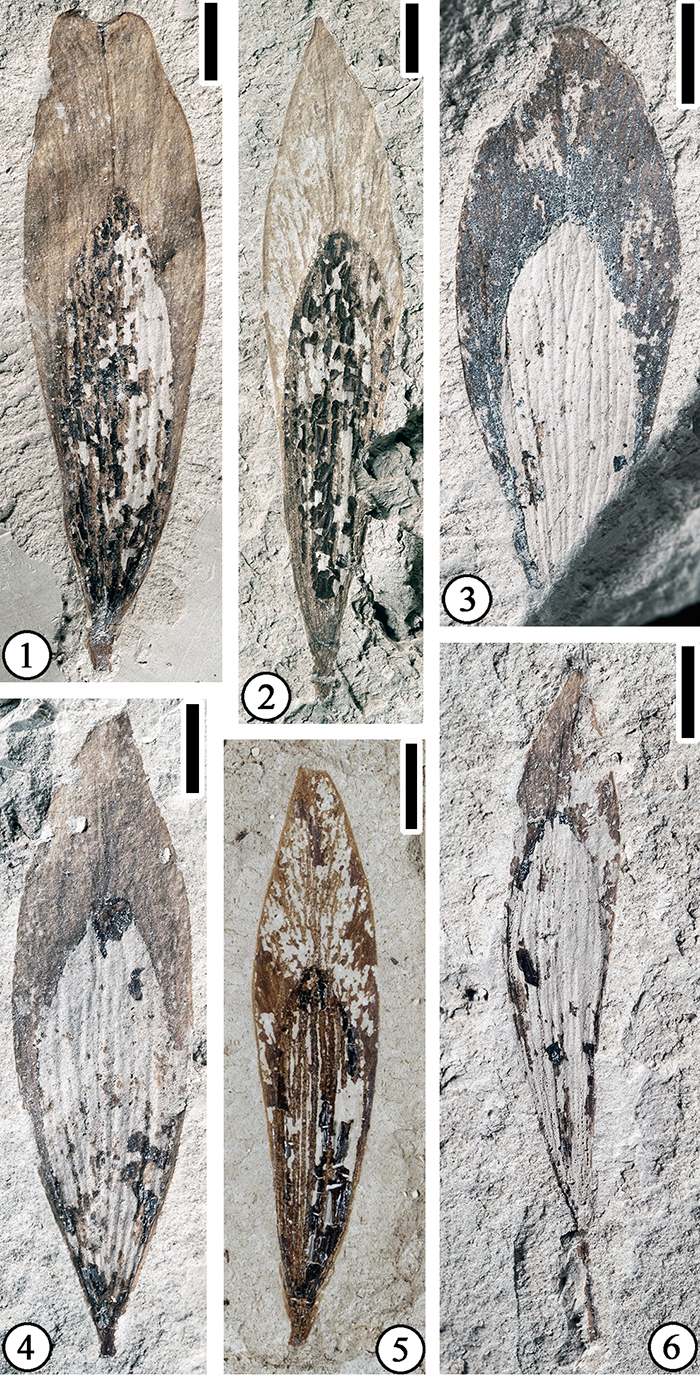
FIGURE 33. “Calycites” puryearensis Berry, 1930: 1) UF15820-059460', specimen showing six floral parts. Scale bar equals 2 mm; 2) Enlargement of the middle portion of a floral part in Figure 33.1 to show venation and trichomes. Scale bar equals 1 mm; 3) UF15820-059460, counterpart of Figure 33.2 showing five floral parts with acute apices. Scale bar equals 2 mm; 4) UF15820-043599, a dispersed floral part. Scale bar equals 2 mm; 5) Enlargement of Figure 33.4 (indicated by arrow) to show anthers clinging to the floral part. Scale bar equals 0.5 mm; 6) counterpart of Figure 33.4. Scale bar equals 2 mm.
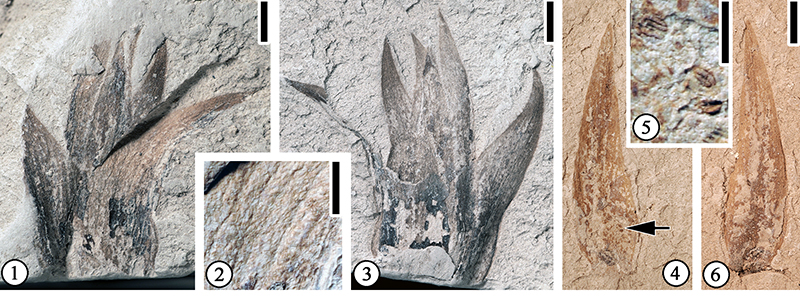
FIGURE 34. Claiborne Floral Type 2: 1) UF15820-002247, flower with a superior ovary (o) which is represented by the depression. Note midvein of a perianth part (indicated by arrow); 2) UF15820-002247', counterpart of flower showing three perianth parts fused at the base and midvein of one perianth part (indicated by arrow). All scale bars equal 2 mm.
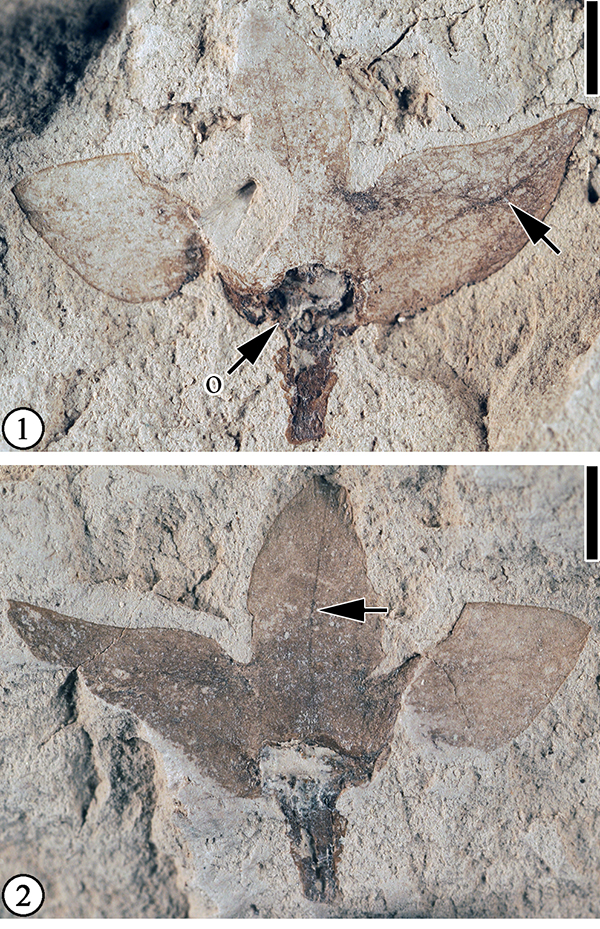
FIGURE 35. Claiborne Floral Type 5: 1) UF15820-061132, showing a vertically preserved flower with five persistent perianth parts. Scale bar equals 2 mm; 2) Enlargement of a perianth part in Figure 35.1 (indicated by arrow) to show reticulate fine venation. Scale bar equals 1 mm; 3) Enlargement of the ovary in Figure 35.1 to show triangular carpels (indicated by numbers). Scale bar equals 1 mm.

FIGURE 36. Claiborne Floral Type 8: UF15820-059478, flower showing alternating sepals (s) and petals (p), and filaments. Note even distribution of filaments. Scale bar equals 1 mm.
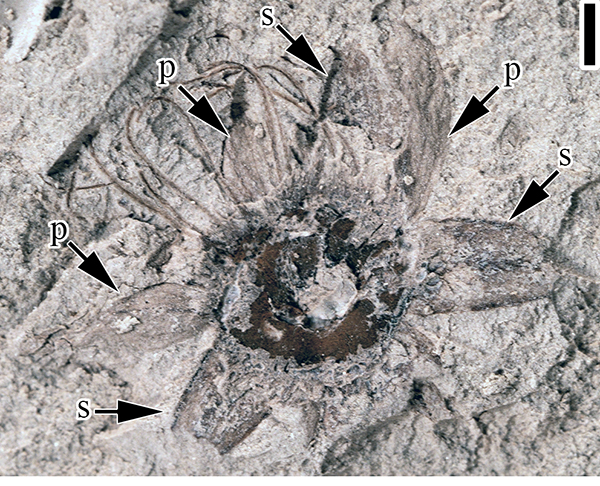
FIGURE 37. Claiborne Floral Type 15: 1) CONN-Q6-02 and 2) UF15820-004686, laterally preserved flowers showing three perianth parts. Note rounded apex of the middle perianth part; 3) UF15820-059404, laterally compressed flower with three perianth parts and a short pedicel (indicated by arrow). All scale bars equal 1 mm.
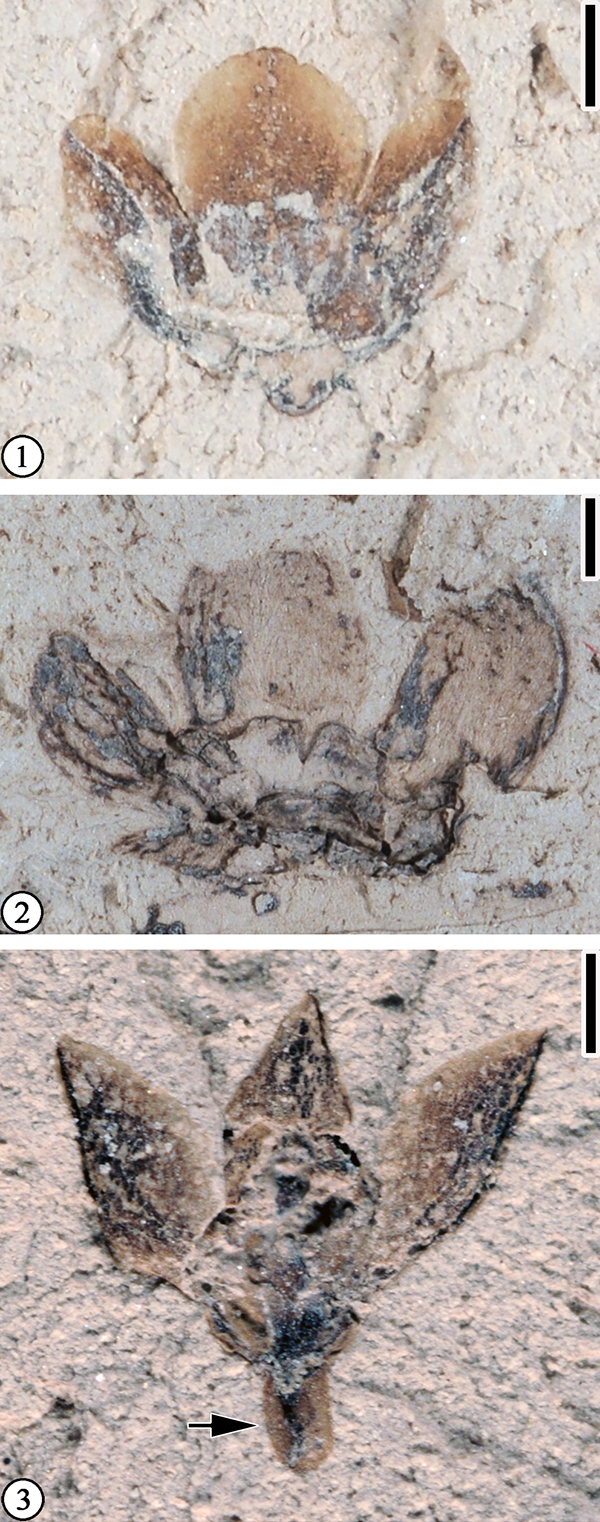
FIGURE 38. Claiborne Floral Type 18: CONN-Q1-P120, laterally preserved flower with clustered stamens (indicated by arrow) and fused filaments, at least two perianth parts, and a short pedicel. Scale bar equals 1 mm.
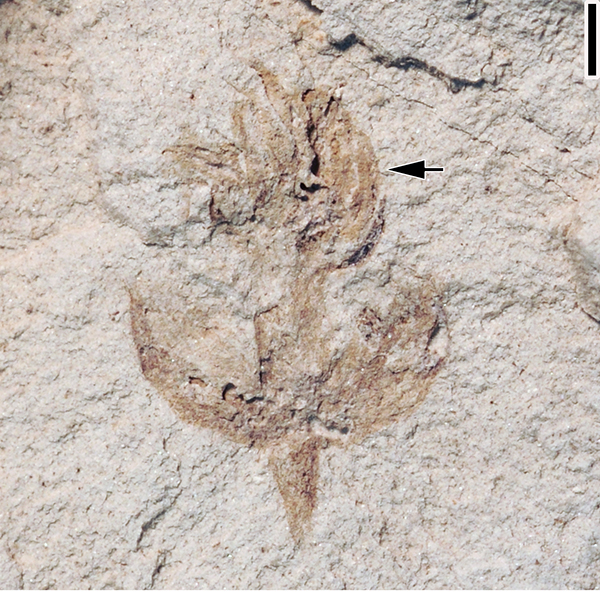
FIGURE 39. Claiborne Floral Type 21: UF15820-059487, showing a broadly obovate petal with a prominent midvein and forking fine veins. Scale bar equals 3 mm.
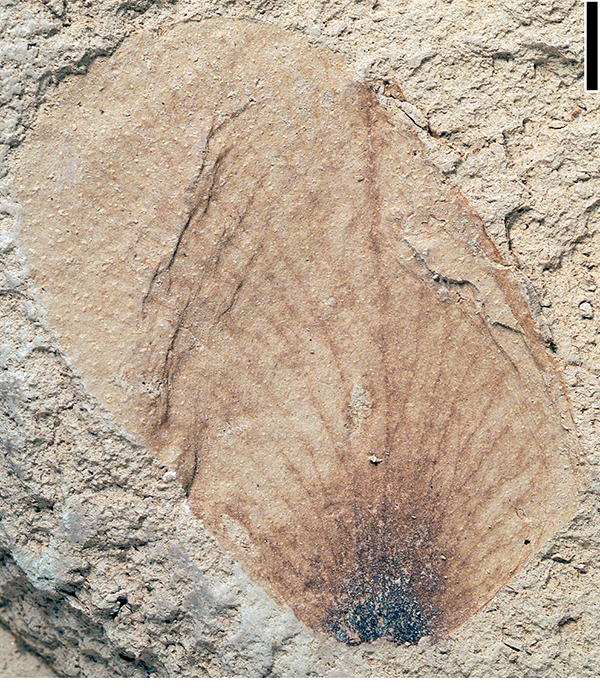
FIGURE 40. Claiborne Floral Type 22: 1) UF15820-002244a', showing a laterally preserved flower. The third and fourth perianth parts are indicated by arrows. Note the parallel veins on the two perianth parts in the middle; 2) UF15820-002244a, counterpart showing the fifth floral part (indicated by arrow). All scale bars equal 0.5 mm.
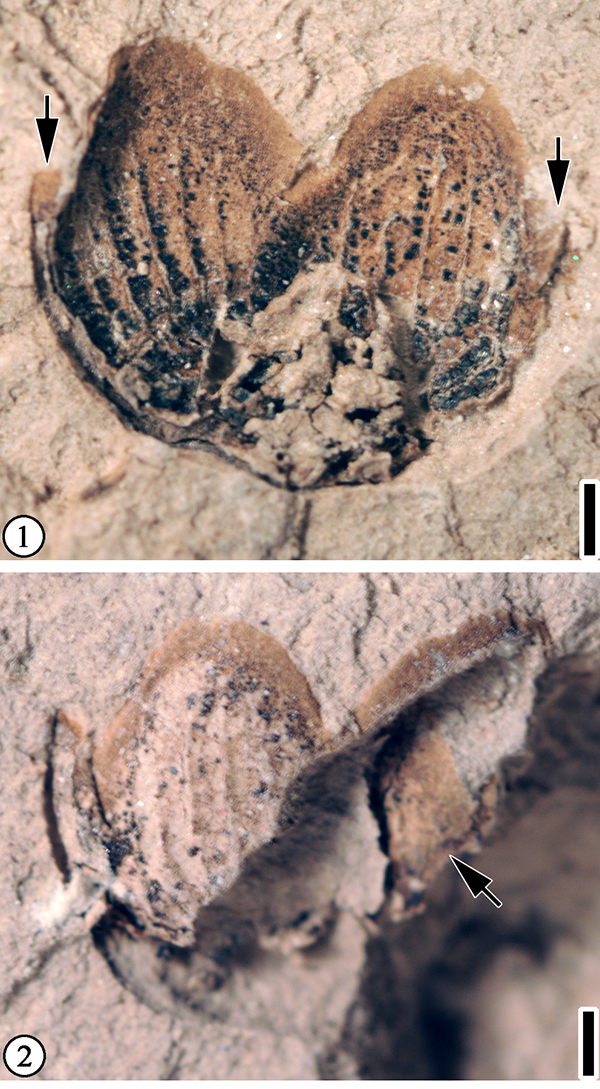
FIGURE 41. Claiborne Floral Type 23: 1) UF15820-002259', laterally preserved flower with five perianth parts. The fourth and fifth parts are indicated by arrows. Note prominent midveins of the perianth parts; 2) UF15820-002259, counterpart showing the elliptic shape, represented by the central perianth part. All scale bars equal 1 mm.
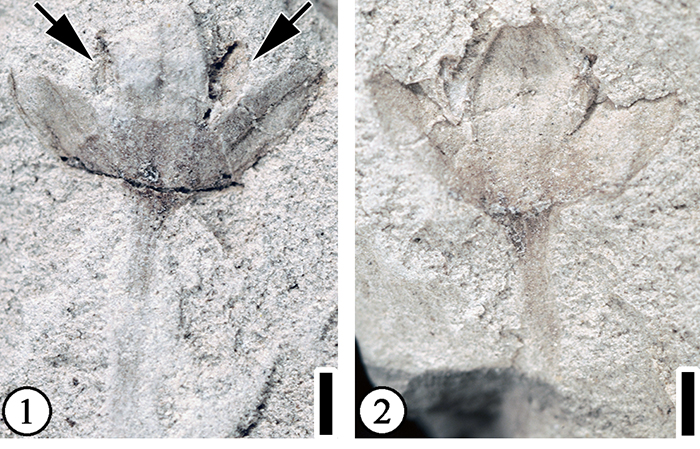
FIGURE 42. Claiborne Floral Type 24: UF15820-043622a, laterally compressed flower with a short pedicel and at least three perianth parts (indicated by arrows). Scale bar equals 1 mm.
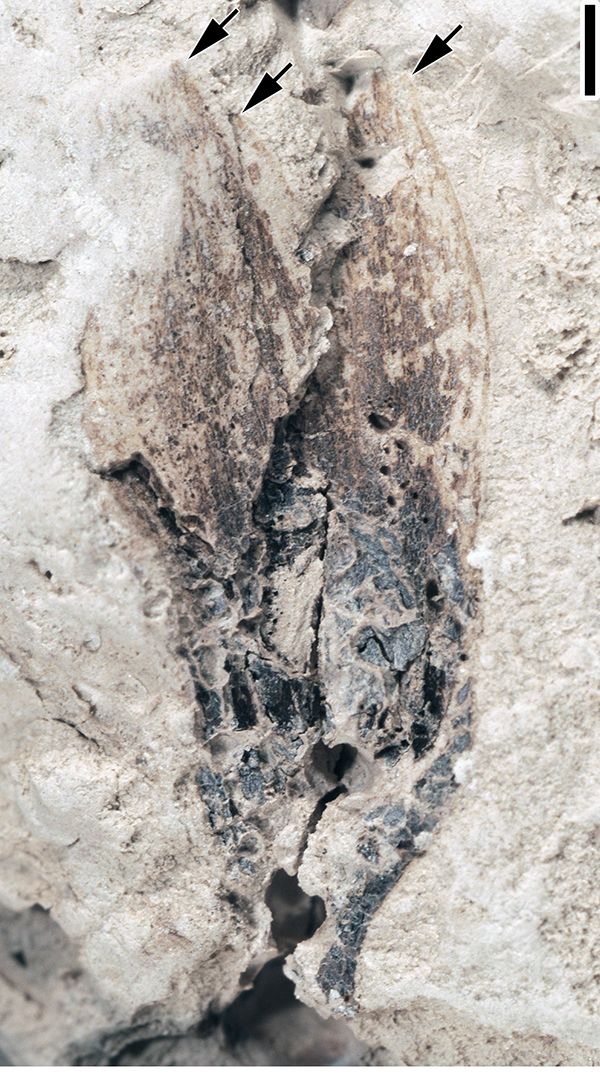
FIGURE 43. Claiborne Floral Type 25: CONN-P121, vertically compressed flower with two whorls of floral parts. Scale bar equals 1 mm.
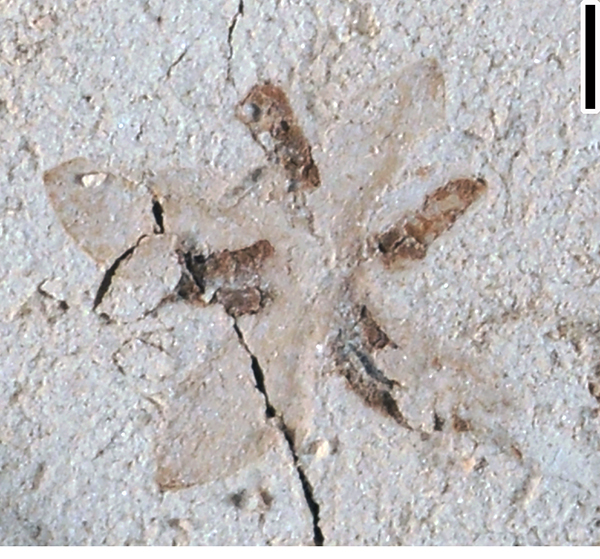
FIGURE 44. Claiborne Floral Type 26: UF15820-002228, laterally compressed flower with at least three floral parts, each with three acrodromous major veins and finer parallel veins, enclosing a suborbiculate part (ovary or fruit?). Scale bar equals 2 mm.
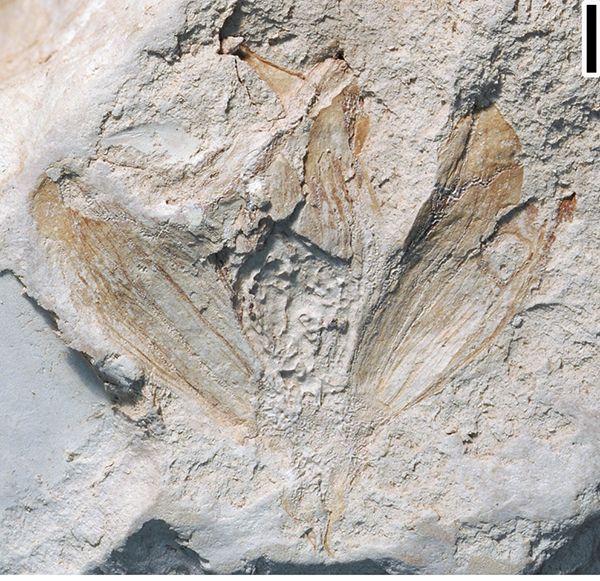
FIGURE 45. Claiborne Floral Type 27: 1) CONN-Q01-18, flower with stamens attached to the base of perianth part (indicated by arrow); 2) CONN-Q06-04a, flower with perianth parts (indicated by arrow) and stamens; 3) CONN-Q01-03, flower with perianth parts (indicated by arrow on the left) and numerous anthers. Note that the connective extends the whole length of the anther (indicated by arrow on the right). All scale bars equal 2 mm.
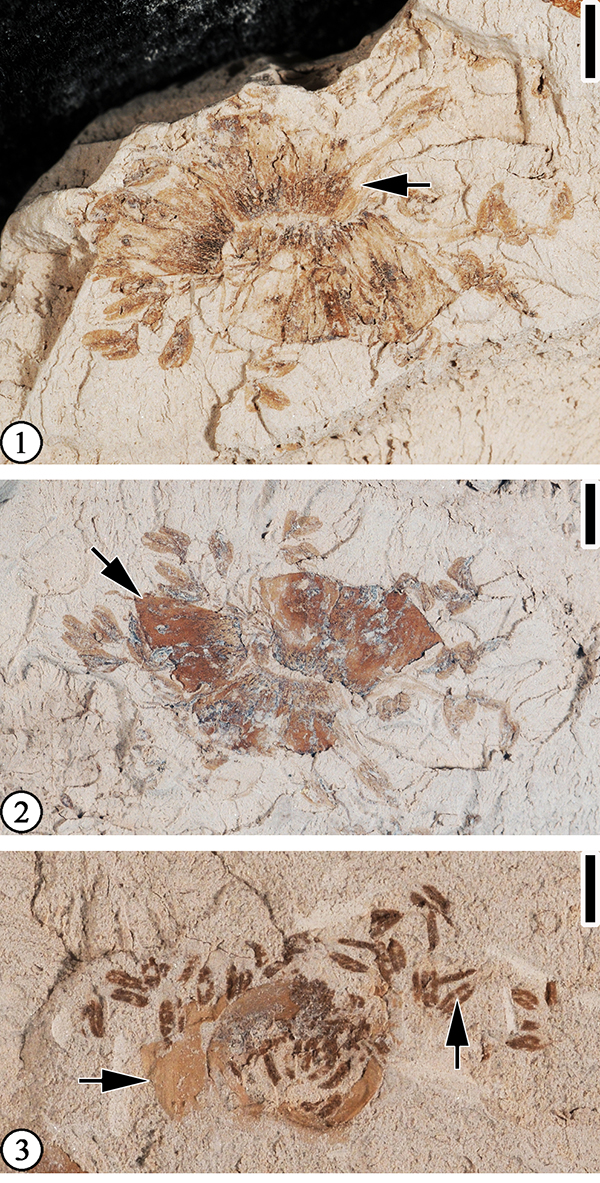
FIGURE 46. Claiborne Floral Type 28: 1, 2) CONN-Q06-11, Q06-11ꞌ, part and counterpart of a flower showing filaments, perianth parts (indicated by arrows), and pedicel. All scale bars equal 1 mm.
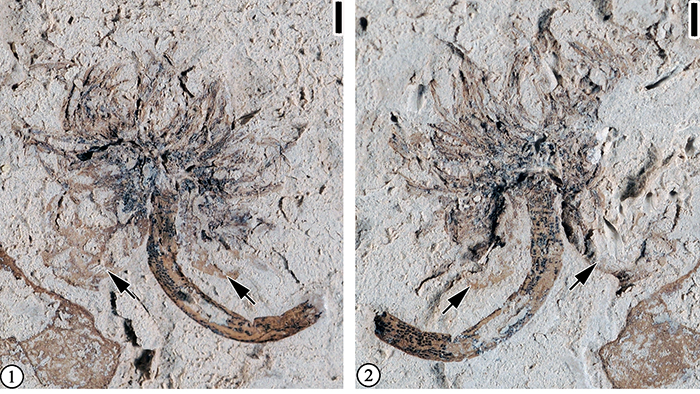
FIGURE 47. Claiborne Inflorescence Type 1: 1) UF15820-043613, showing umbellate inflorescence. Scale bar equals 1 mm; 2) Enlargement of Figure 47.1 to show four floral parts (indicated by arrows), two with floral buds attached and two with only pedicel attached. Note the 4th pedicel and floral bud are superimposed over the peduncle. Scale bar equals 0.5 mm.

FIGURE 48. Claiborne Infructescence Type 1: UF15820-059475, infructescence with helically arranged fruits. Scale bar equals 2 mm.
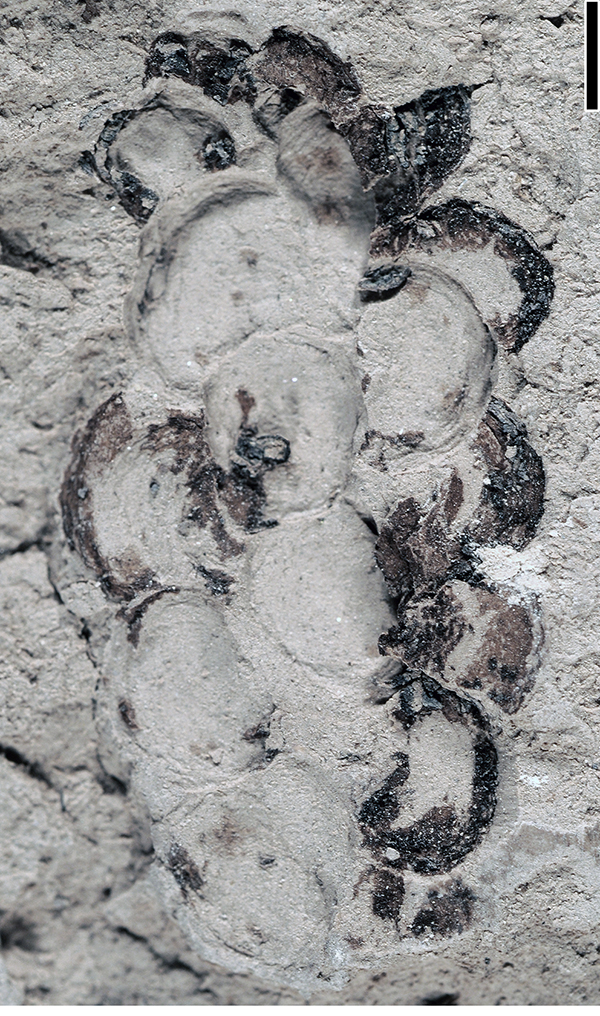
FIGURE 49. Claiborne Infructescence Type 8: 1, 2) UF15820-059392, 059392', part and counterpart of specimen showing paniculate infructescence. Note persistent styles (indicated by arrows); 3) UF15820-059393, specimen showing two lateral pedicellate fruits and one middle sessile fruit. Note perianth parts on two fruits on the left; 4) Enlargement of Figure 49.3 to show perianth parts. Note the middle sessile fruit and two lateral pedicellate fruits, and their size differences. Note three perianth parts of the lateral fruit on the left. Scale bar equals 1 mm; 5) Enlargement of Figure 49.2 to show the middle, sessile fruit and one lateral pedicellate fruit. Note their size difference. All scale bars equal 3 mm except in Figure 49.4, which equals 1 mm, and in Figure 49.5, which equals 2 mm.
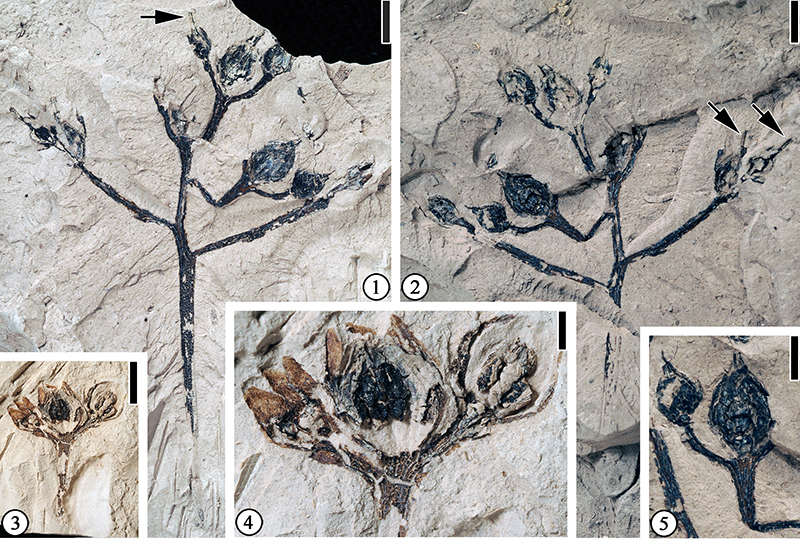
FIGURE 50. Claiborne Infructescence Type 9: 1) UF15820-059394, specimen showing an incomplete infructescence and two dispersed fruiting structures. Note at least eight protrusions, probably representing the bases of pedicels, present on the peduncle. Scale bar equals 3 mm; 2) Enlargement of Figure 50.1. Scale bar equals 1 mm; 3) Enlargement of Figure 50.1 to show spines on the fruiting structures. Scale bar equals 1 mm.
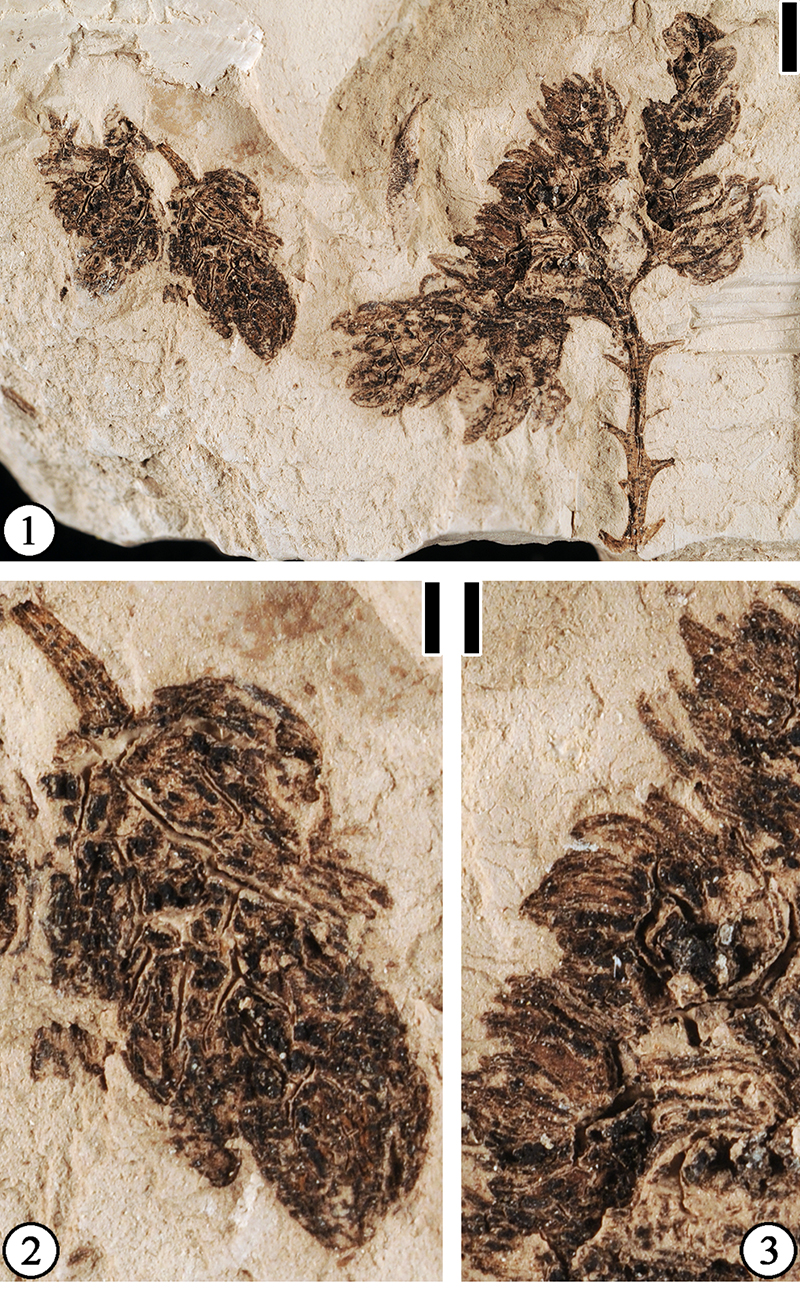
FIGURE 51. Claiborne Infructescence Type 10: 1) UF15820-059472, specimen showing an infructescence; 2) UF15820-061124, showing two superimposed infructescences. Note individual fruits with rounded or truncate apices (indicated by arrow). All scale bars equal 1 mm.

FIGURE 52. Claiborne Infructescence Type 11: 1) UF15820-059400, infructescence with two fruits; 2) UF15820-061140, a dispersed fruit with a decurrent base and a pedicel. All scale bars equal 3 mm.
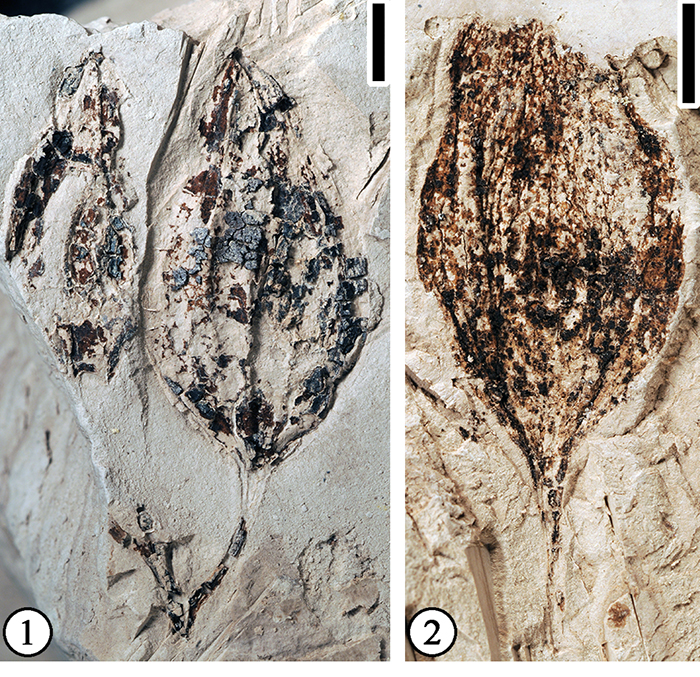
FIGURE 53. Claiborne Infructescence Type 12: UF15820-061143, a branched axis bearing three elliptical/obovate fruits. Scale bar equals 3 mm.
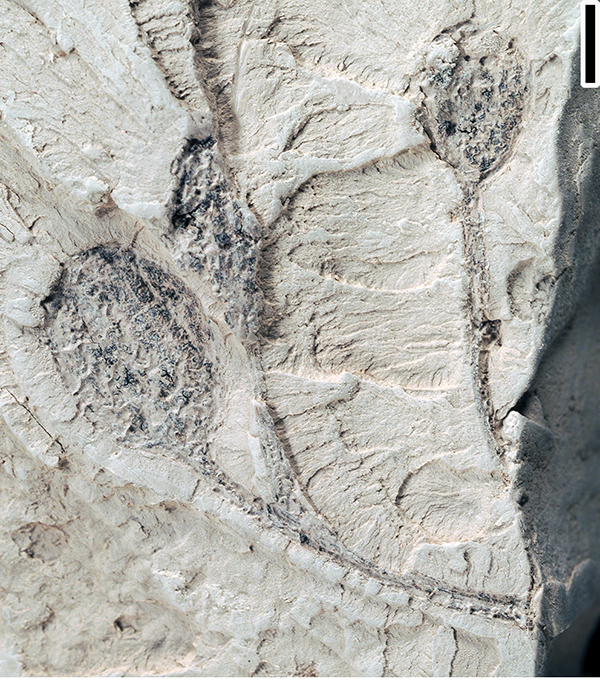
FIGURE 54. Claiborne Infructescence Type 13: 1, 2) UF15820-043602, 043602', vertically preserved infructescence with three globose fruits. Arrow in Figure 54.2 indicates a depression, suggesting the presence of a peduncle. All scale bars equal 3 mm.
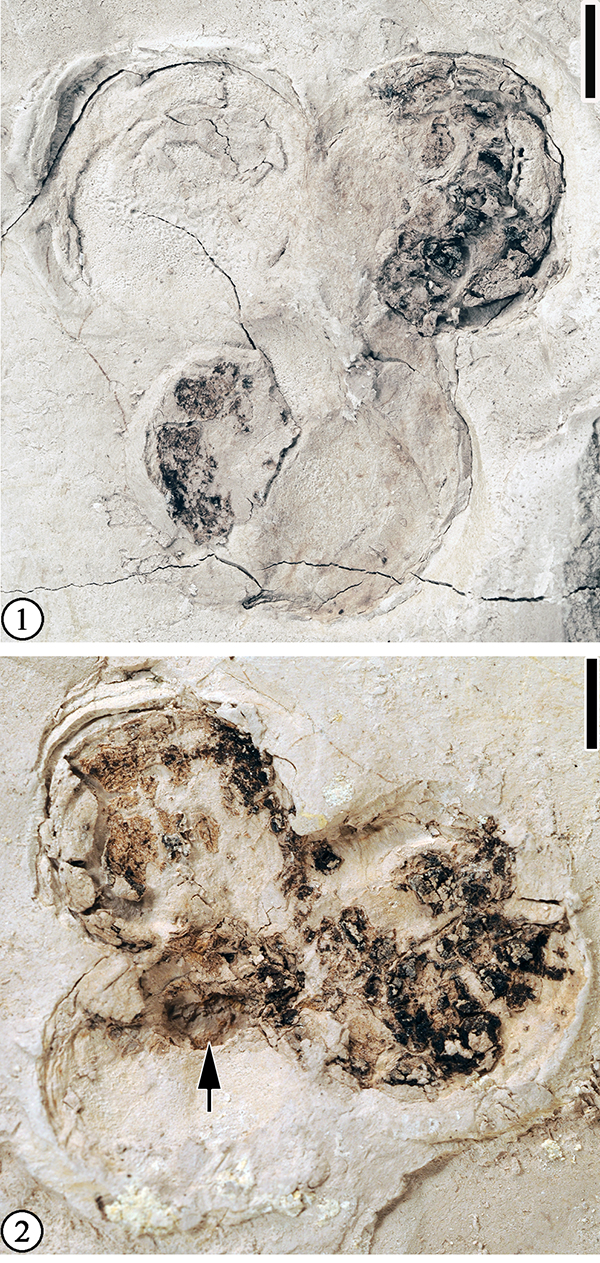
FIGURE 55. Claiborne Infructescence Type 14: CONN-R1-01, specimen showing at least four infructescences. The one in the middle has a long peduncle attached. Scale bar equals 3 mm.

FIGURE 56. Carpolithus prangosoides Berry, 1916: 1) UF15820-048318, a large fruit with elliptic fruit body and three wings (indicated by arrows). Scale bar equals 4 mm; 2) Enlargement of Figure 56.1 to show reticulate venation of the fruit wing. Scale bar equals 1 mm; 3) UF15820-059471', seven immature, elliptic fruits about 5 mm long and 1.8 mm wide. Note that two fruits on the left and two fruits at the lower right overlap. Scale bar equals 3 mm; 4) UF15820-048319, a fruit with rounded wing apices. Scale bar equals 4 mm; 5) Enlargement of two fruits in Figure 56.3 to show thin fruit wing (indicated by lower right arrow) and fruit body (dark area indicated by upper left arrow). Scale bar equals 1 mm; 6) Enlargement of distal part of fruit in Figure 56.4 to show at least four wings (indicated by arrows). Scale bar equals 1 mm; 7) UF15820-059459, a laterally compressed floral structure with attached pedicel. Scale bar equals 2 mm; 8) Enlargement of the apical portion of Figure 56.7 to show the light-colored perianth parts (indicated by arrow) and enclosed darker structure. Scale bar equals 1 mm; 9) Enlargement of the basal portion of Figure 56.7 to show the pedicel (indicated by arrow). Scale bar equals 1 mm.
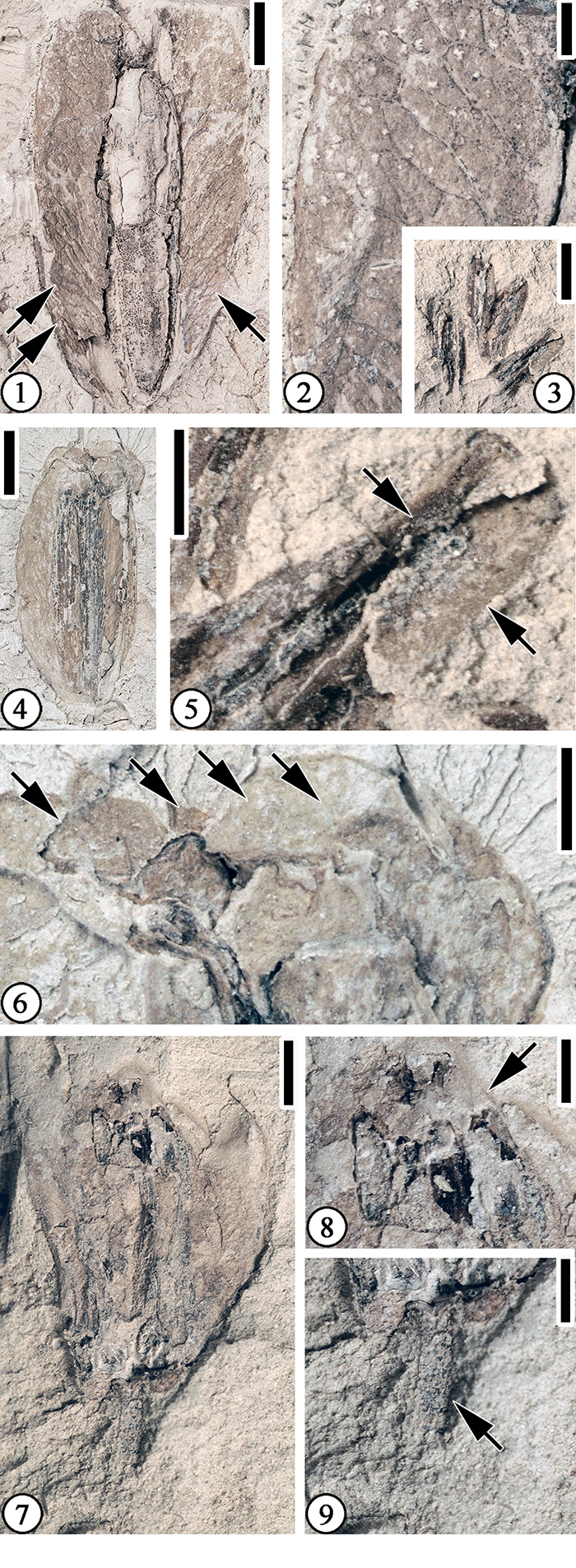
FIGURE 57. Carpolithus warmanensis Wang, Blanchard and Dilcher, 2013: 1) CONN-Q7-01, suborbiculate fruit with spines. Note a zone ca. 1 mm thick (indicated by arrows) surrounding the seed; 2) 15826-051471, reniform fruit from the Warman clay pit. All scale bars equal 2 mm.
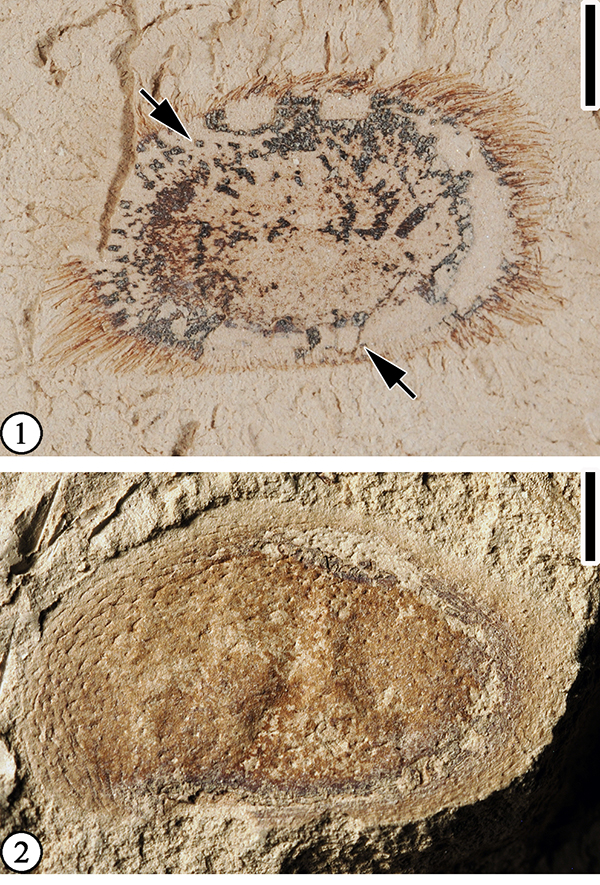
FIGURE 58. Palmocarpon wilcoxiana (Berry) Wang, Blanchard, and Dilcher, 2013: 1) UF15820-043616, a large endocarp ca. 29 mm long and 10 mm wide; 2) UF15820-059402, an endocarp with a middle ridge (indicated by the black arrow) and two grooves (indicated by the two white arrows); 3) UF15820-059470, a small endocarp; 4) UF15820-007246, an endocarp with a middle groove (indicated by arrow). All scale bars equal 3 mm.
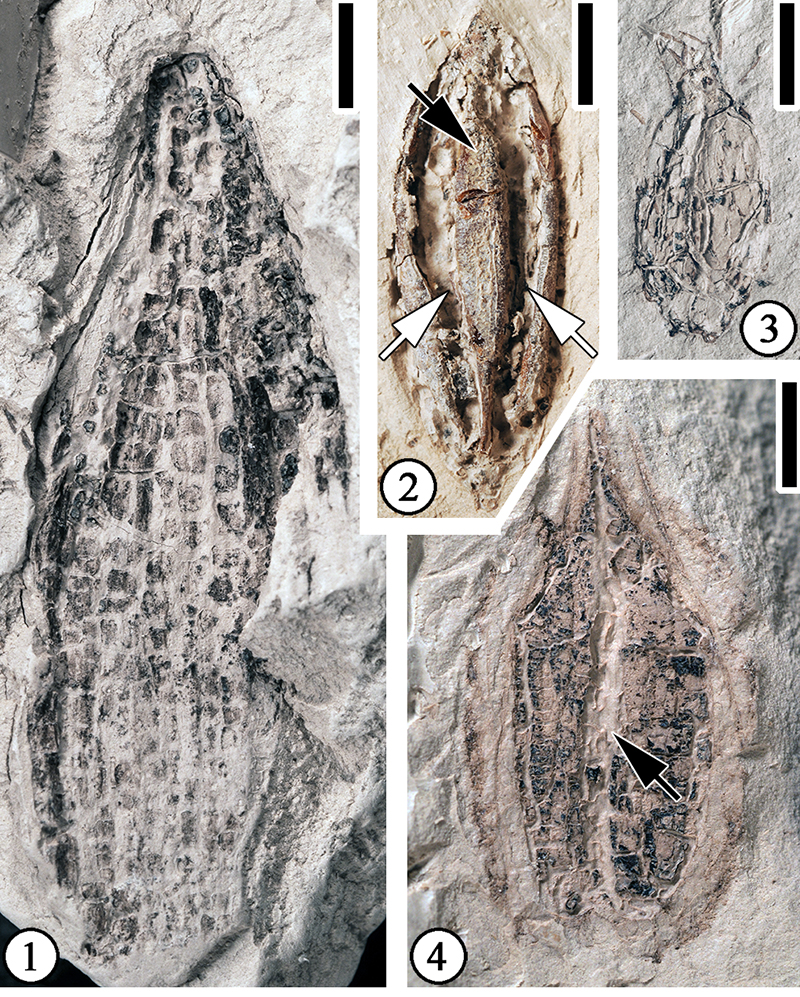
FIGURE 59. “Ficus” fructus pedicellata Berry, 1930: 1) UF15820- 059484, a smaller fruit with an attenuate apex, a receptacle (indicated by arrow) and a long pedicel; 2) UF15820-061125, a larger fruit with a receptacle (indicated by arrow) and an incomplete pedicel. All scale bars equal 3 mm.
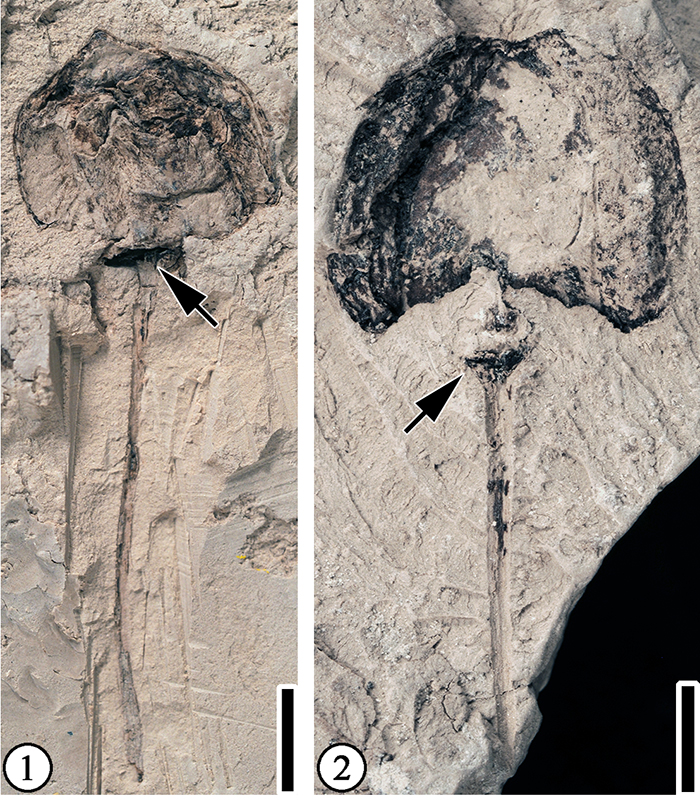
FIGURE 60. “Ptelea” eocenica Berry, 1930: 1) CONN-Q2-03, specimen showing a fruit with two fusiform seeds; 2) CONN-Q3-07, specimen showing reticulate venation of fruit wing; 3) UF15820-059403, specimen showing pedicel, fruit wing, and a fusiform seed. All scale bars equal 2 mm.
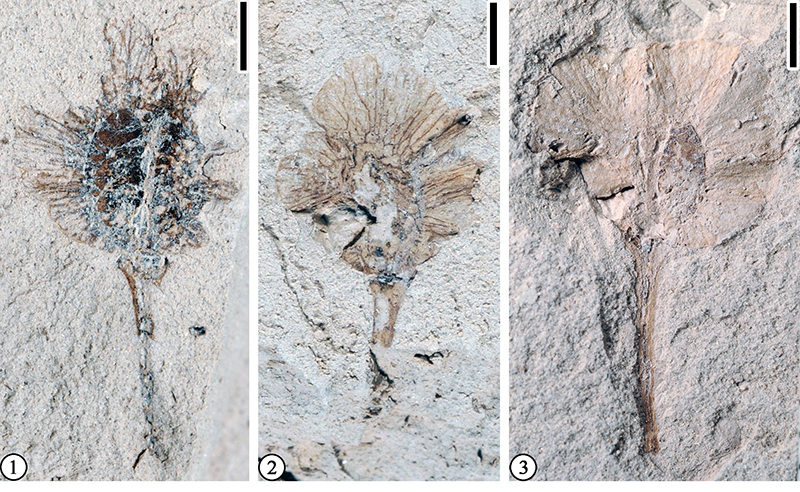
FIGURE 61. Claiborne Fruit/Seed Type 2: 1) UF15820-002240, laterally compressed fruit/fruiting head with apically split appendages (indicated by arrow); 2) UF15820-059485, laterally compressed spatulate fruit/fruiting head with a stout peduncle/pedicel (indicated by arrow). Cornerocarpon copiosum Grote (compressed, charcoalized fossil specimens for comparison): 3) UF15815-008198, laterally compressed fruit showing a peduncle (indicated by arrow); 4) 15815-53095, laterally compressed fruit showing broken bracts (indicated by arrows). All scale bars equal 3 mm.
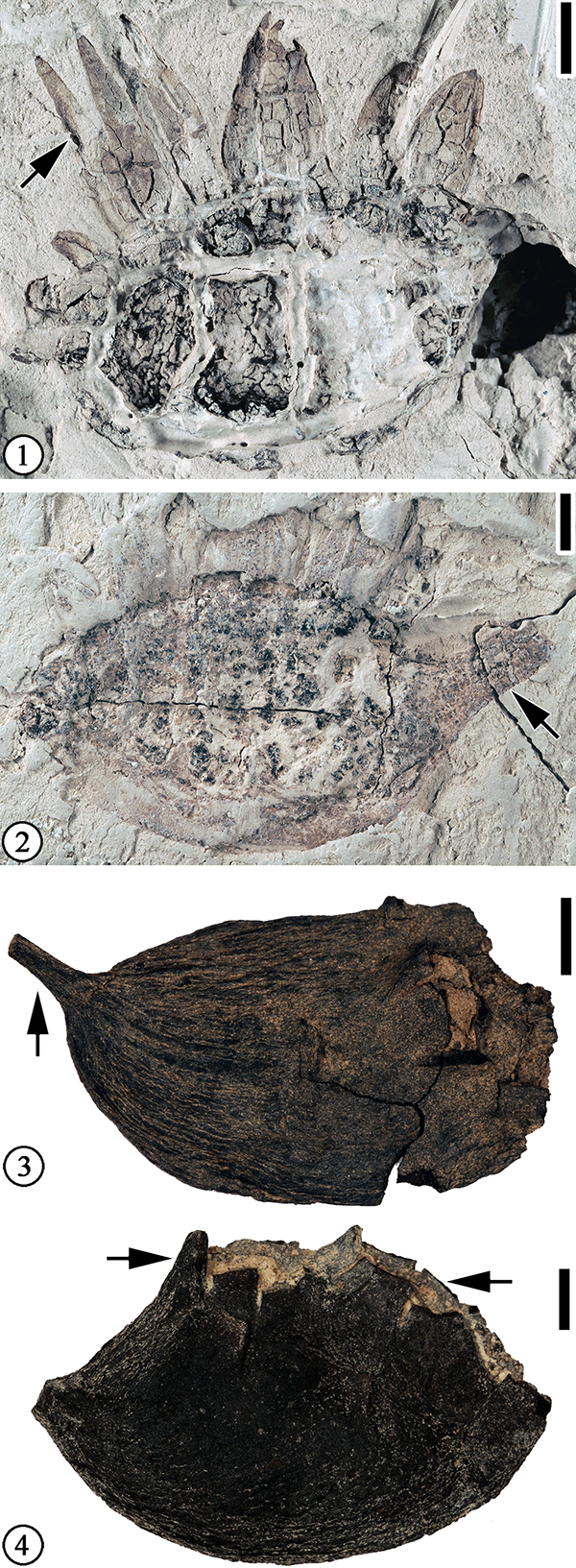
FIGURE 62. Claiborne Fruit/Seed Type 6: UF15820-043597, compressed fruit/seed with a reticulate surface pattern. Scale bar equals 2 mm.

FIGURE 63. Claiborne Fruit/Seed Type 11: UF15820-061123, specimen showing an elliptic disseminule with an apical extension that is decurrent on one side and extends to the base (indicated by four white arrows). Note two overlapping lateral attachments (indicated by black arrows). Scale bar equals 1 mm.

FIGURE 64. Claiborne Fruit/Seed Type 12: UF15820-061144, showing an orbicular fruit with an apical projection at the distal end (indicated by arrow) and a stout pedicel at the base (indicated by arrow). Scale bar equals 1 mm.
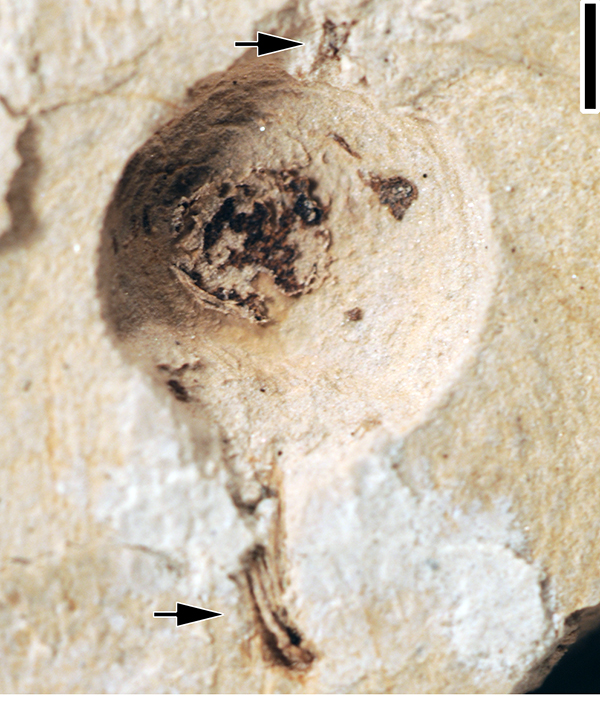
FIGURE 65. Claiborne Fruit/Seed Type 13: UF15820-059205, showing incomplete, dehiscent capsule with three valves observed. Note seed impression (s), two marginal zones on each valve (indicated by white arrows), and the notched valve apices. Scale bar equals 5 mm.
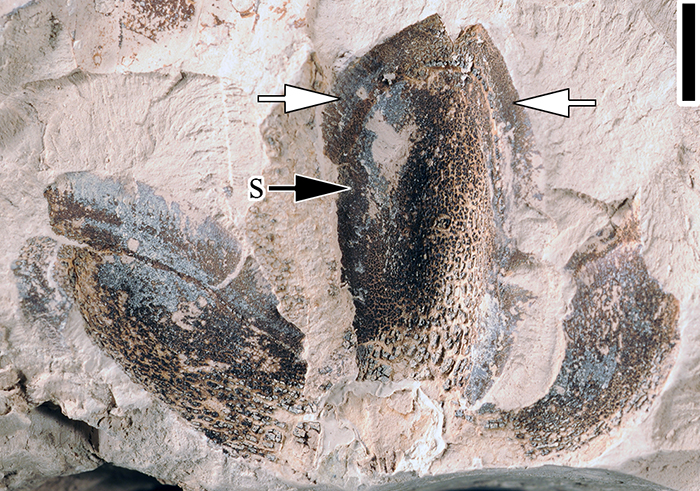
FIGURE 66. Claiborne Fruit/Seed Type 14: UF15820-059406, fruit with seven seeds enclosed in fruit wall (indicated by arrows). Scale bar equals 3 mm.
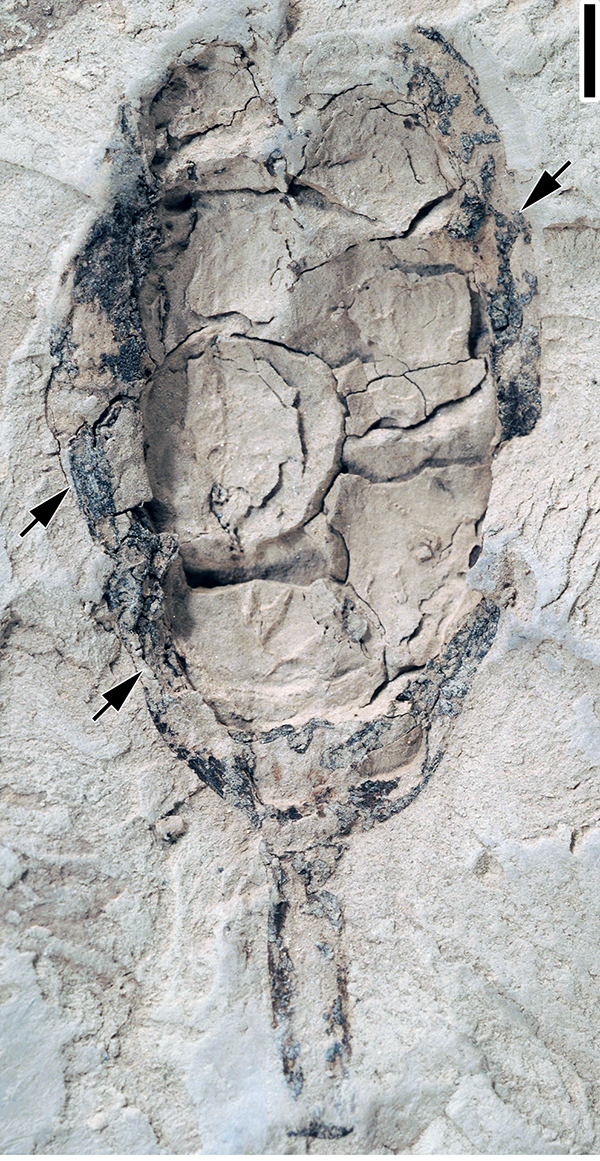
FIGURE 67. Claiborne Fruit/Seed Type 15: 1, 2) UF15820-059466, 059466', part and counterpart of a specimen show two overlapping bracts enclosing another structure with a prominent middle ridge/grove (indicated by arrows). All scale bars equal 1 mm.
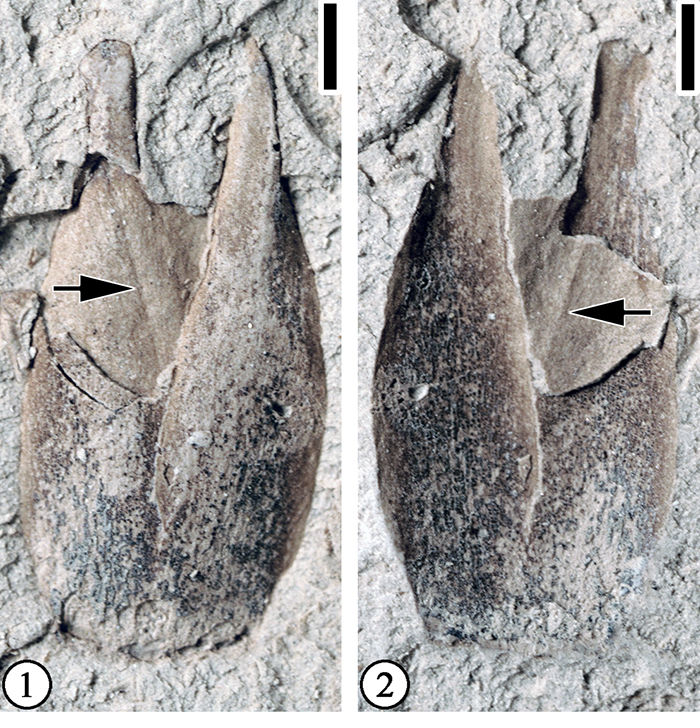
FIGURE 68. Claiborne Fruit/Seed Type 16: UF15820-059479, laterally compressed ovoid fruiting structure. Scale bar equals 3 mm.

FIGURE 69. Claiborne Fruit/Seed Type 17: 1) UF15820-059455, laterally compressed obovate reproductive structure; 2) UF15820-059486, a smaller fruit/seed with an attached pedicel. All scale bars equal 2 mm.
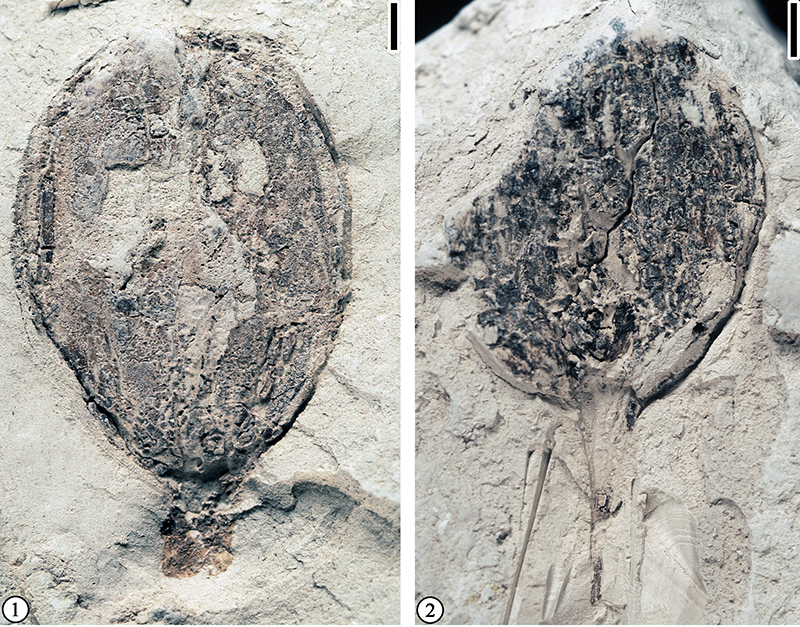
FIGURE 70. Claiborne Fruit/Seed Type 18: CONN-Q09-02, laterally compressed fruit/seed with attached pedicel and apical spine. Scale bar equals 2 mm.
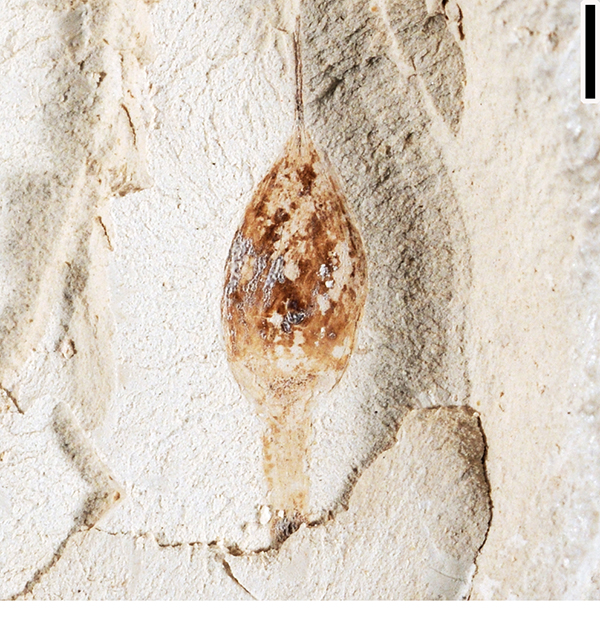
FIGURE 71. Claiborne Fruit/Seed Type 19: 1) CONN-Q1-P19, specimen showing circular fruit body with spines and an incomplete wing. Scale bar equals 4 mm; 2) Enlargement of the lower left of Figure 71.1 to show spines. Scale bar equals 1 mm; 3) Enlargement of Figure 71.1 to show veins (indicated by arrows) Scale bar equals 1 mm.
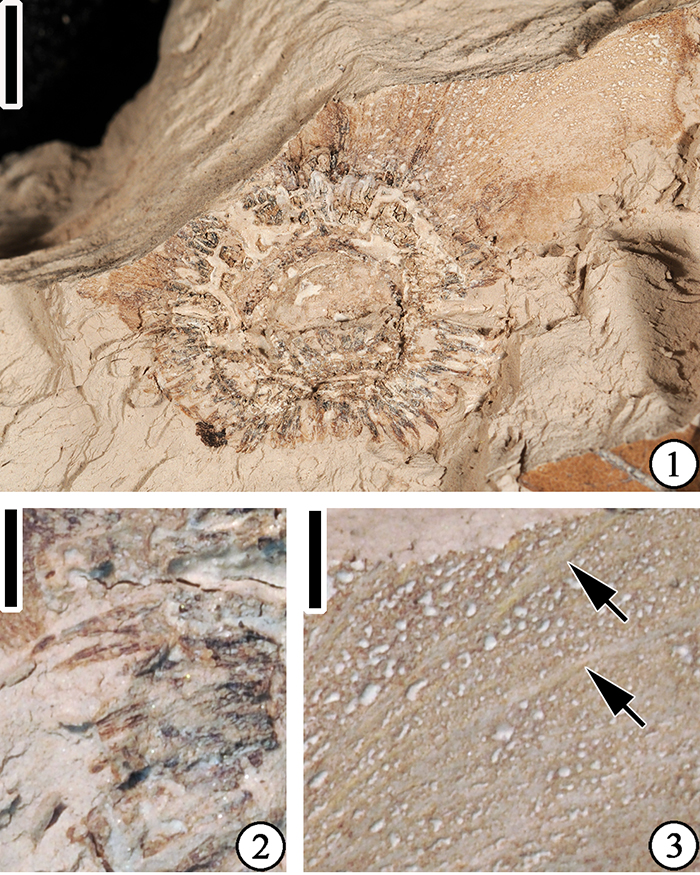
FIGURE 72. Claiborne Bract Type 1: 1) UF15820-059452, an orbicular bract with auricular base on one side and slightly cordate base on the other side. Note parallel veins in the middle and convergent veins on two lateral sides of the bracts; 2) Enlargement of Figure 72.1 to show trichomes; 3) UF15820-059456, bract with a cordate base; 4) UF15820-059454, an ovate bract. Note parallel veins in the middle and convergent veins on lateral sides of the bract; 4) UF15820-059462, a lanceolate bract. All scale bars equal 3 mm, except in Figure 72.2, which equals 1 mm.
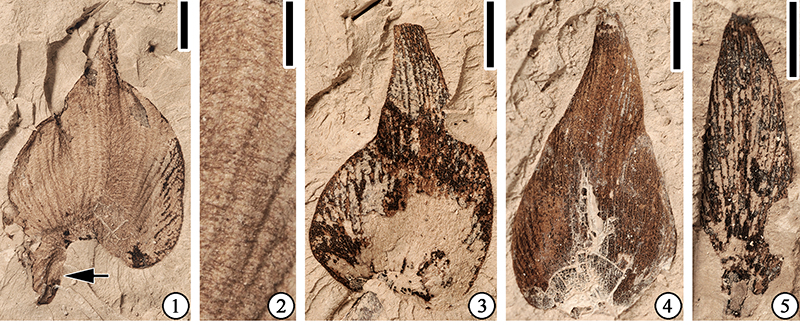
FIGURE 73. David Dilcher collecting fossil plants at the Puryear clay pit, Tennessee, in the summer of 1959.
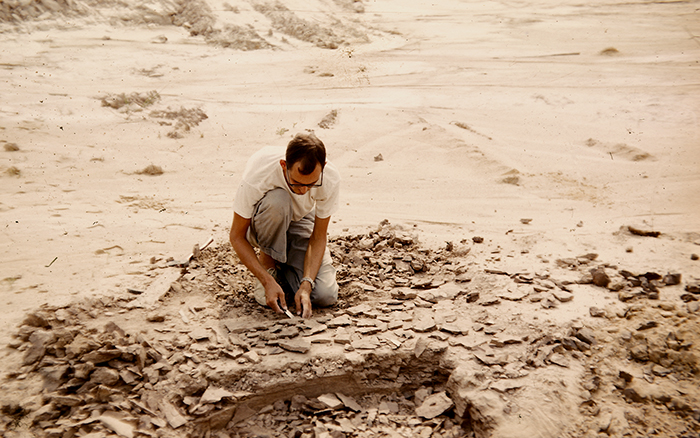
Tables

